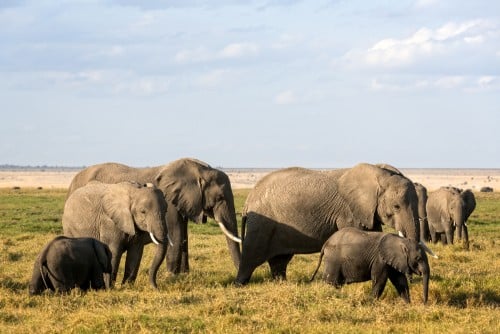What happens when a hunter kills the leader of the elephant herd? A new study found that the mother's social network is used by the daughter to keep the herd stable

Einat Bar Ziv, Angle - Science and Environment News Agency
Every 15 minutes an elephant is killed in the world. According to WWF - the international organization for the protection of wild animals - since 1979 the African elephants (Loxodonta africana) have lost more than half of their habitats. This fact, combined with hunting for ivory (the value of which is now worth more than gold), caused the elephant population to drop sharply - from several million at the beginning of the XNUMXth century to less than half a million today.
Elephants are social animals: females live in herds, while males often live alone or alternatively form small groups with other males. The social structure in the group of females is complex and hierarchical, and is divided into social ranks - which on the one hand are distinct and easy to identify, and on the other hand maintain connections between them. In the middle are the older females in the herd ("Matriarchs"), who form a sort of bridge between the social layers, and are the central and significant figures in the herd.
When there is harm to a social animal, it must be taken into account that this does not harm only the specific individual. The injury may destroy the social fabric, and lead to secondary injuries also in the other members of the family and the group, or in this case - the herd.
A new study by doctoral student Shafra Goldenberg from the University of Colorado examined how hunting of older females, who are socially key figures in elephant herds, affects the social structure of the entire herd. The research team compiled 16 years of data collected from the elephant population in Kenya's Samburu National Park. From the data, the researchers mapped the "social networks" in the population - with which individuals each of the elephants chooses to be and create interactions, which of the individuals is more central, how many connections he has and whether they are close or loose.
for future generations
Contrary to expectations, the researchers found that when the female-leader is killed, this does not cause the social structure of the rest of the herd to be undermined. According to the study, an offspring of the dead female makes use of the social network created by the mother and establishes close social ties with those females who were close to her mother. This is how she takes her place, and the social hierarchy is maintained. In this way, even in cases where key details of the structure come out of it, the overall structure can be maintained - a fact that makes the herd more durable and immune to external influences.
The study also found that the switching of roles is not only passive. From a young age, the females are more active in creating connections that are not in their closest social circle, and thus the young women establish a social circle themselves. When the time comes, when you need to replace one of the older fillies, they will be "fit" for the job. Of course, here too, the creation of connections was conditioned by the social environment to which they were exposed by the mothers. Females whose validations were socially close developed close bonds as well.
The findings from the study are indeed encouraging, but it must be remembered that the older females have knowledge and experience that the younger females did not necessarily have enough time to acquire. In a world of changing climate, which brings with it long periods of drought, remembering the location of distant water and food sources becomes critical, and directly affects the survival of the next generation of elephants.
19

3 תגובות
It's called networking
Wow, what "research" and another new one? If the researcher had read local legends or listened to the stories of the "old men" she would have known that everything she wrote here has been known for hundreds of years, at least. And maybe she decided to copy from the local culture and appropriate it for herself. Too bad.
Inaccurate as there are surveys that show the bad influence of orphans
About orphaned males, who due to the lack of "maternal education" become aggressive
towards other animals,
The cases in which elephants killed rhinos and buffaloes are known.
When the history of the killers was examined, it turned out that they were orphans...